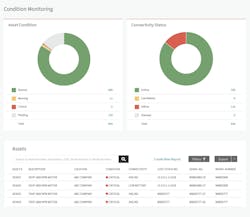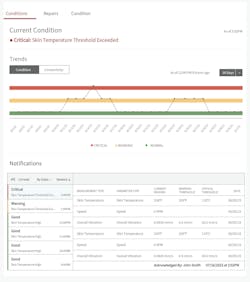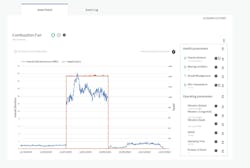Selecting the ideal predictive maintenance plan for your motors
It is 2 a.m. on a Monday. You receive a text notification that a primary motor on your production line is operating outside normal parameters. After reviewing the data on your plant dashboard, you contact the plant and get maintenance to adjust the process to keep the motor running. Meanwhile, you click on the asset detail, review the current price and availability, click “order,” request same-day delivery and return to bed.
Science fiction? Hardly. The supply chain has caught up with technology; it can integrate online monitoring to help predict failures and connect you with the assets you need, when you need them. However, the responsibility for building a strategy that takes advantage of modern machine health technology ultimately is up to you.
Three key sources of motor health data
There have been significant improvements in the number of facilities across the U.S. that operate with these technologies. To understand where we are today, it is important to understand the past (and present for many) in the form of three key types of motor health data.
Offline Static Electrical Testing. A plant critical motor has failed. If the motor is larger than 50 hp, you send it to the local motor repair shop for failure analysis and to find a replacement. The repair shop has several diagnostic tools to test the integrity of the damaged motor and windings. These include several tests to determine the motor’s viability and the shop’s ability to return it to as-new condition. These static tests are primarily concerned with the motor windings and insulation system. Parameters tested include surge, polarization, winding resistance, and megohm. A high potential test will inform how the motor handles electrical loads and current.
The Internet, trade journals and maintenance publications are full of advice on static motor testing procedures during planned outages and using that data to predict or stave off an unexpected failure based on current motor condition. Portable, easy-to-use tools are readily available to conduct the same offline static tests your local motor shop does.
Static testing information is useful to prepare for future issues, but do the results help explain the failure’s cause? Was the cause a power spike, lightning, or a locked rotor failure? Did the motor heat cause bearing failure, or did the bearings fail due to motor heat? Reliable shops can depend on years of experience to provide some direction, but the resulting failure analysis is often more of an opinion than something verifiable.
The big savings benefit from static testing is that a replacement can be funneled into a planned outage to control or eliminate unexpected downtime. Wouldn’t it be better to not only extend the motor life but address the root cause?
Online Vibration/Temperature Monitoring. Since about 2008, motor-mounted sensors have provided active temperature and vibration monitoring. These include simple devices that offer “red, yellow, green” outputs (determined from set min/max points) to sensors providing full wireless data output of raw information. Either way, these sensors deliver data that the maintenance engineer can use to uncover health trends as the motor wears and plan around them (see Figure 1).
Sensor technologies pave the way for more accurate identification of issues in real time, but they also introduce new concerns. Since only vibration and temperature are being monitored, these sensors cannot help monitor or troubleshoot power-related problems (spikes, surges, unclean power). Another significant consideration is that these are point-of-use devices mounted directly on the motor wherever it lives. Now, the delicate sensor must survive in the same environment as the motor.
Online Electrical Testing. The newest gold standard of motor analysis is electrical signature analysis (ESA). It monitors and collects data using motor current signature analysis (MCSA) and motor voltage signature analysis (MVSA). Both are “energized” testing and monitoring methods, like vibration and temperature data collection, that occur while the motor operates. Line and current voltage data are often collected inside the motor control center (MCC) using current and voltage transducers.
Data collection from these devices can add insight and identify many operational problems that lead to premature failures. Information can be viewed in real time, revealing a motor’s reaction to loads, power quality, controller issues, and insulation/winding integrity problems as they develop. One of the biggest advantages of this type of data logging is that the sensors live in the MCC, out of harm’s way. This is not a standalone solution, but one that gives different insight while the equipment operates.
Using all three to build a holistic motor condition monitoring strategy
The solution is much more holistic if you combine data collection from all three sources: static testing, vibration/temperature, and ESA. Together, these provide all the insight possible to manage your motor assets much more effectively—but there is yet another important issue to consider. Each sensor manufacturer has their own software ecosystem and associated monthly or annual fee for data analysis. A complete motor data collection system on a single motor could involve three or four different information providers. This means up to four reports must be compiled and reviewed at the plant level to effectively prepare and plan. Even with all these data and analysis providers, there is still no detail about the asset itself —availability, upgrades, warranty, etc.
Next-level monitoring puts that type of comprehensive solution into the palm of your hand (or directly to your phone/tablet or computer). Several standalone predictive maintenance service companies or distributors can serve as your “data warehouse” by reviewing and interpreting all of that single-source raw data for you. To illustrate how this would work, let’s consider another critical motor application, but on a smaller motor (25 hp) that would typically not be rebuilt.
This 25 hp motor runs a critical combustion fan, and vibration and temperature sensors were recently installed to monitor asset condition. Data are reported to a dashboard several times daily with monitoring provided remotely. The vibration analyst identifies on a Wednesday that the motor bearings are in third-stage failure due to fan imbalance. This issue is identified early enough that you can refer to your distributor’s dashboard. From there, you can order a replacement to arrive the next day. You are shutting down the plant on Friday, and the motor will be staged and ready to replace. While the plant is down, you will open, inspect and clean the fan blades at the analyst’s recommendation.
On Friday, everything goes according to plan with the outage, and you start up the combustion fan and tell the analyst about the work performed. They can go into the dashboard, look at the data and confirm that the new motor is running smoothly, and that the fan imbalance is negligible after cleaning (see Figures 2-4).
Build your custom motor health strategy
Unfortunately, no one-size-fits-all strategy will work for every facility or industry. The best way to apply these technologies at your facility will depend on your assets, asset criticality, typical failure modes, and the capabilities of your maintenance and reliability organization. For example, you may choose simple current monitoring paired with a few vibration and temperature sensors on medium-criticality assets in your facility, and increase the number of vibration sensors for higher-criticality assets. For the higher-criticality assets, you may start with periodic offline static motor testing. Another facility may follow a similar process but use ESA because some critical assets have very large motors.
Companies need to select the ideal predictive maintenance plan based on various factors, which can vary significantly between locations. The best recommendation is to partner with an experienced third-party team that can help advise on the best brand-agnostic approach for each of your facilities, keeping your unique parameters in mind.




